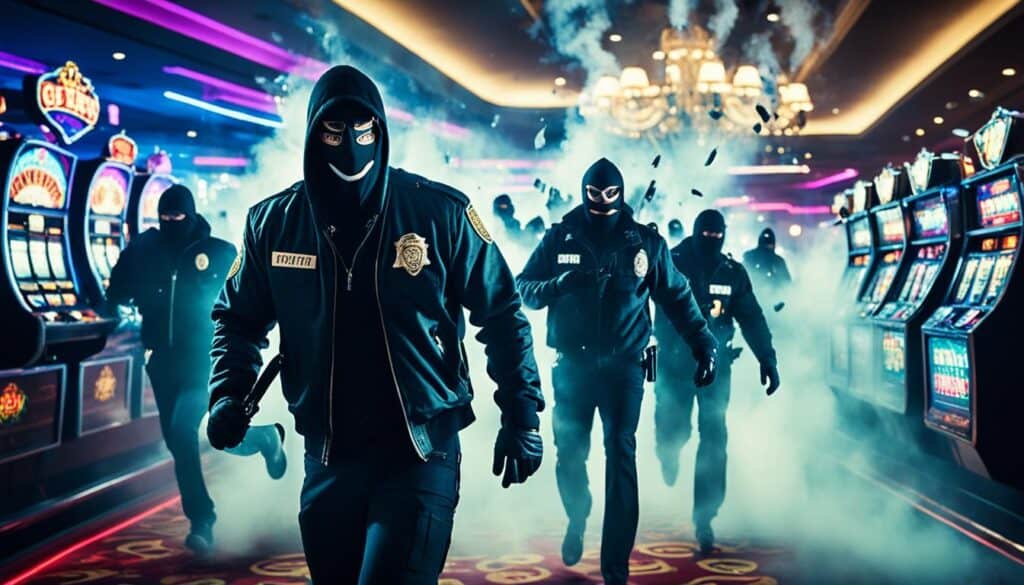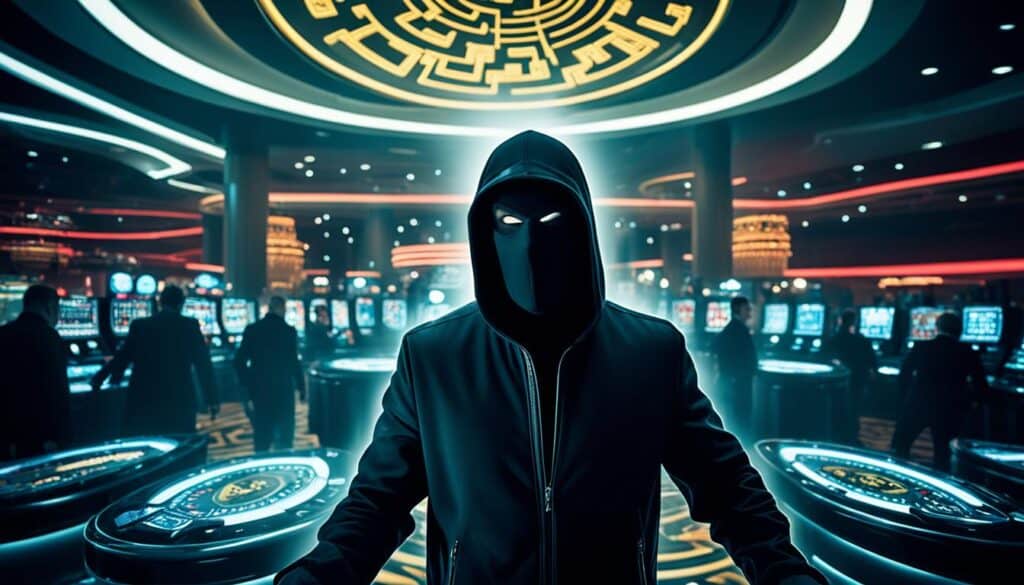The allure of the forbidden and the thrill of the heist have perennially drawn attention to the high-stakes world of casino robberies. This captivating blend of risk, strategy, and the shimmering allure of quick fortunes has made casino heists a perennial topic of interest. From the velvety casino floors thrumming with the energy of chance to the darkened theatres where audiences are regaled with tales of audacious capers, the fascination with casino robberies spans both real-life and fictional realms.
Intricately plotted real-life capers have secured their place in history, compelling not just news headlines but also the creative visions of filmmakers. As we peel back the layers of these stunning plots, the taut line between fact and fiction emerges, mirroring the very essence of the casino world where every game hinges upon a blend of luck and skill. Modern casinos match wits with would-be robbers through cutting-edge security, creating an ever-escalating game of cat and mouse between the house and those who endeavor to beat it at its own game.
Step into this world where the glimmer of riches casts long shadows, and the siren call of the perfect heist reverberates through the corridors of imagination and reality alike.
The Allure of Casino Heists in Cinema
![]()
Embraced by audiences worldwide, casino heist films have become a significant part of popular culture, capturing the imagination with tales of high-risk gambles and ingenious money-snatching schemes. These narratives, spotlighting iconic Las Vegas heist films, often stand at the intersection of cinematic spectacle and the looming reality of casino security. The catalog of notable titles like Casino Royale and Ocean’s Eleven demonstrates the genre’s potent mix of reality and fantasy, reeling viewers into the luxurious yet perilous world of casino heist cinema.
Indeed, these films excel at painting the casino scene as a canvas of clashing wits and glimmering lights, where fortunes pivot on the brink of daring moves and intellectual heists. Below is an exploration of how these movies have integrated into the tapestry of popular cultural phenomena:
- By leveraging the allure of the untouchable casino vaults and the thrill of strategizing the perfect crime.
- Portraying the heart of Las Vegas as the ultimate jackpot, ripe for the taking by a clever mix of charismatic antiheroes.
- Incorporating real-world gaming practices and settings, they tether the cinematic universe to a tangibly high-stakes environment.
While the escapades in Ocean’s Eleven may embellish the felicity of slipping past security, they set the stage atop very real Vegas casinos, fusing the silver screen with the city’s actual glitz and glamour. Similarly, Casino Royale resonates deeply with audiences, mirroring the sophistication of world-renowned gambling establishments, albeit through the lens of a fictional narrative.
The influence of such cinema is undeniable; they encapsulate a realm where Robin Hood meets James Bond, mixing moral ambiguity with unparalleled suavity. These films are where viewers vicariously revel in the vicissitudes of fortune—where the next twist in the tale is as unpredictable as a roll of the dice in the sleepless heart of Nevada.
Real-Life Casino Robberies That Shook the World

While the glittering world of casinos often conjures images of high-stakes games and luxurious opulence, the history of gambling is also marked by daring and audacious heists. Some of these historical casino heists have not only shocked the world but have also served as gripping inspirations for Hollywood’s most thrilling casino-centric films.
Historical Casino Heists that Inspired Hollywood
It’s not just the fictional glamour of the silver screen; some of the biggest casino heists of the century have indeed mirrored blockbuster plots. The masterminds behind these robberies have become legends in their own right, with their notorious escapades echoing through the corridors of infamy.
Famous Casino Robberies and Their Masterminds
- Heather Tallchief’s involvement in the Circus Circus heist turned her into a notorious figure. In 1993, with elaborate planning and precision, she managed to drive away with a loot exceeding $2.5 million. Her story is not just one of criminality but also of enigma, as she successfully evaded law enforcement for years before her eventual surrender.
- Bill Brennan, in contrast to Tallchief’s elaborate scheme, is known for his startlingly simple approach to thievery. One day, while working at the Stardust Casino, he simply walked out with bags containing half a million dollars and vanished, leaving behind a trail cold enough to perplex even the most dedicated detectives.
- The Crown Casino Heist in Australia paints a picture of techno-crime sophistication. A high-roller, in cahoots with an insider, used the casino’s own surveillance system to secure a $33 million windfall. Though Crown Casino was quick to respond, the heist remains a stunning testament to the vulnerabilities of even the most advanced security networks.
Casino Heists in Film: Fact vs. Fiction

Exploring the thrilling world of casino heist movies, audiences are often captivated by the portrayal of thieves and their complex schemes to outsmart real-world casino security. However, separating the cinematic versions from what’s actually possible proves to be a revealing study of fact versus fiction.
- While films like “Ocean’s Eleven” provide a sleek and ingenious look at stealing from high-security vaults, in reality, casinos employ technologically advanced measures to foil such attempts.
- Security systems involve a network of cameras, facial recognition software, motion detectors, and silent alarms – far removed from the vulnerability portrayed on screen.
- Every move on the casino floor is monitored by trained professionals, who scrutinize for any unethical activity, making the life of a movie-like casino thief a much less glamorous prospect.
- The dramatized success of on-screen heists is thus met with the sobering truth that today’s casinos are bastions of surveillance and security.
The allure of the heist remains a strong narrative force in film, but when compared to the fortified reality of modern casinos, these stories stand as entertainments that should not be mistaken for practical how-to guides for aspiring criminals.
“Casino Royale”: Blending Fiction with Casino Realities

The allure of the high-stakes poker scene in “Casino Royale” showcases a masterful blend of cinematic fiction and the thrill of real-world gambling. With Daniel Craig’s iteration of James Bond, the movie elevates the prestige and tension of casino culture, captivating audiences with a mix of luxe environments and nail-biting gameplay. Although the film’s Casino Royale is a product of the imagination, the portrayal resonates with the experiences of actual high rollers, drawing a compelling parallel that bridges the gap between narrative and reality.
Impact of James Bond on Casino Heists Genre
The iconic character of James Bond, as reprised by Daniel Craig in “Casino Royale,” has significantly influenced the casino heist genre. Bond’s suave demeanor and sharp intellect have become synonymous with the sophisticated world of casino espionage. His presence in literature and film has perpetuated a distinct blend of elegance and danger, setting a benchmark for heist narratives and reinforcing the casino setting as a staple backdrop for high-stakes dramas.
Real High-Stakes Poker Games Portrayed in Film
It’s not just the fictional representation that grips our fascination; the authenticity of high-stakes poker games in “Casino Royale” is indicative of the genuine atmosphere found in top-tier gambling venues. The game’s tension mirrors true-to-life poker showdowns occurring in destinations like Las Vegas and Monte Carlo, serving as a testament to the real emotions and strategies involved in wagering vast sums. While the film might animate the narrative with theatrical license, the essence of the poker play truly captures the essence of high-stakes gambling.
Understanding the Obsession with “Ocean’s Eleven”

The heist genre has witnessed numerous interpretations in Hollywood, but none have gripped the audience quite like “Ocean’s Eleven.” This film extravaganza is a blend of celebrity charm and the intrigue of a seamlessly planned casino robbery. With stars like George Clooney and Brad Pitt gracing the screen, and the opulent backdrop of Las Vegas providing luxurious accommodations, audiences are swept into a world where the stakes are high, and the gameplay is nothing short of legendary.
The Cast’s Real-Life Casino Experiences
Amidst the glamour and thrill of the onscreen action, the cast of “Ocean’s Eleven” reportedly indulged in poker games behind the scenes. These off-screen games weren’t just for leisure; they fostered a sense of brotherhood that shone through their on-screen interactions. Games between takes included George Clooney and Brad Pitt, who have been icons in bringing the casino culture to a wider audience, glorifying the suspense-filled moments at the tables, much like the high-rollers who frequent the world’s grandest casinos.
Comparing Fictional Heists to Actual Casino Security
While “Ocean’s Eleven” elevates the heist to an art form, the real-life counterparts, such as the Bellagio, combine luxurious allure with a security apparatus that would easily foil the fictionally perfect crimes. Portrayed heists offer viewers a temporary escape into the world of flawless crimes, but they stand in stark contrast to the near-impenetrable security that modern casinos employ. These institutions are fortresses of surveillance and contingency planning, making the likelihood of replicating an “Ocean’s Eleven” scenario quite improbable outside the realm of cinema.
- Luxurious casino settings rivaling Hollywood sets.
- High-stakes games reflecting true gambling culture.
- The disparity between on-screen heists and real-world casino defense mechanisms.
Analyzing “Casino”: The True Story Behind the Movie

Delving deep into the heart of Las Vegas’s gambling scene, Martin Scorsese’s “Casino” provides a stark look at the intricate relationship between the casino industry and mob influence. The film, anchored by a riveting performance by Robert De Niro, brings to life the complex persona of Frank “Lefty” Rosenthal, a renowned figure in the world of gaming and bookmaking, who managed multiple casinos, including the legendary Stardust Casino.
- Frank “Lefty” Rosenthal’s management of Stardust Casino underpins the narrative, offering an insider view of the mob’s control over Las Vegas gaming operations.
- The dramatization of actual events and figures like Rosenthal and his cohorts highlights the intertwined relationship between organized crime and the casino business during the 1970s and 1980s.
- Scenes such as the infamous ‘pen scene’ reflect Scorsese’s commitment to portraying the raw and often violent reality behind the glamorous casino façade.
Despite the movie’s focus on past events, contemporary Las Vegas has undergone a transformation. Today’s casinos are governed by strict regulations and corporate oversight, a shift from the mob-run establishments of Rosenthal’s time. The transformation from mob influence to corporate governance has altered the essence of the city’s casino operations, prioritizing legality and fairness.
Nonetheless, “Casino” remains significant not only as a powerful piece of cinema but also as a historical document that chronicles a pivotal era in Las Vegas history. It’s a sobering reminder of the city’s evolution from its notorious past to the security-first mentality of the present-day casino industry.
The Influence of “The Sting” on Casino Heist Narratives

Given its compelling narrative and dramatic flair, “The Sting” has made a significant impact on the casino heist genre. This iconic film, which starred the legendary duo of Paul Newman and Robert Redford, masterfully combined suspense and strategic gaming in a storyline that audiences found irresistible. Its timeless charm is reflected in the casino heist stories that have followed, showing the undiminished power of smartly crafted con artist narratives in cinema.
Award-Winning Film’s Contribution to Casino Heist Stories
The legacy of “The Sting” on the portrayal of casino heists in popular culture cannot be overstated. Its influence paved the way for a genre that blends the excitement of high-stakes gambling with the cunning required to outsmart opponents. The film, which won seven Academy Awards, including Best Picture, owes its success to a combination of smart storytelling, exceptional acting, and a lively ragtime soundtrack that brought the bygone era to life.
Realism of Con Games in the Casino Environment
While “The Sting” was set during a time when gambling dens were far from the regulated establishments we know today, the movie’s portrayal of card games and betting schemes still resonates with modern audiences. The film’s detailed depiction of con games mirrors the psychology of real-world gambling, although today’s casino environment is equipped with advanced security measures that protect against the execution of such elaborate cons.
In-Depth Look at Card Counting Through “Rain Man”

The film Rain Man, with its riveting performance by Dustin Hoffman, delves into the intricate world of blackjack through the lens of an individual with an extraordinary talent for card counting. With scenes shot in the bustling casinos of Las Vegas, the movie provides a window into the strategy of card counting. Primarily, it involves tracking the ratio of high to low cards remaining in a deck, allowing skilled individuals to adjust their bets based on the probable outcomes.
Despite the allure depicted in the film, and contrary to what some may believe after watching Hoffman’s character master the blackjack tables, card counting is not an illegal activity. However, casinos naturally frown upon it, as it can give players an edge over the house. Today, gambling establishments have adopted robust methods to counter card counters, such as using multiple decks or employing continuous shuffling machines. The approach of card counting, while intellectually attractive, has become an increasingly challenging practice from which to garner consistent profits within the modern casino environment.
- Casinos’ Countermeasures Against Card Counting:
- Implementation of multiple deck games to dilute the count.
- Continuous shuffling machines to keep cards randomized.
- Surveillance systems to monitor suspected card counting behavior.
- Prohibiting mid-shoe entry to prevent counters from joining at advantageous times.
- Consequences for Successful Card Counters:
- Being asked to play other games besides blackjack or refrain from betting.
- Facing potential bans from the casinos if identified as a skilled counter.
The film’s impact on the casino industry also led to some individuals attempting to mimic Hoffman’s character’s abilities. These individuals, fascinated by the prospect of beating the casinos at their own games, have frequently found themselves on the other side of the casino’s stringent policies, with some indeed getting banned from casinos for their card counting attempts.
While Rain Man may have romanticized the concept of successful card counting leading to life-altering wins, the reality presented by modern casino security measures is starkly different. The once possible edge for skilled card counters has diminished over time due to these rigorous counteractions by gambling establishments. Thus, the legacy of Rain Man endures not only through Hoffman’s remarkable portrayal but also through the ongoing conversation about the fairness and feasibility of card counting in the ever-evolving landscape of casino gambling.
Dissecting the MIT Blackjack Team’s Story in “21”

The enthralling tale of the MIT Blackjack Team as depicted in the film “21” strikes a chord with anyone fascinated by the complex world of card counting techniques. This professional review seeks to dive into the accuracy of the film’s portrayal, the real-life saga of the team, and the intriguing persona brought to the screen by Kevin Spacey.
The Real MIT Team vs. Their Hollywood Counterparts
The silver screen adaptation brought to life by actors like Jim Sturgess and Kate Bosworth takes certain creative liberties, yet it preserves the essence of the true story. The painstaking efforts to train actors in the ways of the MIT Blackjack Team underscore a dedication to realism, bridging the gap between the film’s dramatization and the real-world experiences of these famed card counters.
Card Counting: Movie Magic or Feasible Casino Strategy?
Despite the romanticized cinematic representation, “21” ignites discussion about the practical aspects of card counting. It’s a world that balances on the edge of risk, skill, and the formidable security measures of present-day casinos. With real establishments employing advanced strategies to combat such techniques, the feasibility and sustainability of card counting are called into question, setting the stage for a deliberation on whether art imitates life or vice versa.
Exploring Casino Heists in Early Cinema: “5 Against the House”

Delving into the roots of the casino heist genre, we must pay homage to the pivotal role of “5 Against the House.” This seminal film directed by Phil Karlson played a fundamental role in shaping the heist narrative that has become a beloved staple in cinematic history. Examining the components of this classic can provide us with a deeper understanding of its enduring influence.
In “5 Against the House,” audiences are teased with the thrill of the Harold’s Club casino robbery, a daring plot concocted not by hardened criminals, but by college students. As one of the earliest heist films, it manages both to intrigue and to charm, setting itself apart as a reflection of the era’s cultural attitudes towards such high-stakes adventures.
How Classic Films Paved the Way for Modern Casino Heist Movies
The impact of “5 Against the House” on modern cinema cannot be overstated. The film’s innovative narrative structure and the psychological complexity of its characters became trademarks that influenced future filmmakers. The daring heist at the core of the story, combined with the personal dynamics of the friends involved, created a template for the blend of tension and drama that characterizes today’s heist films.
The First Portrayals of Casino Robberies on the Big Screen
Before Ocean’s Eleven and Casino carved their names into heist movie history, “5 Against the House” took the lead. Its portrayal of the Harold’s Club casino heist was groundbreaking, lacking the advanced technology and elaborate schemes seen in contemporary films but rich in raw planning and human ingenuity. Highlighting the creativity required to execute such a feat back then, Karlson’s film invites us to appreciate the ingenuity behind one of the first major cinematic forays into the world of casino robbery.
Robberies in Reel: Misconceptions Versus Casino Policies

Cinematic depictions of casino heists often captivate audiences with their high-stakes drama and elaborate planning. Yet, what many viewers accept as real within these narratives can create misconceptions about actual casino operations and the legitimacy of certain gambling strategies. Specifically, the dramatic portrayal of card counting can mislead some to believe it’s a devious or illegal practice, further fueled by films such as “Rain Man”. However, in reality, casinos adhere to strict casino policies designed to protect their business and customers, often misrepresented by Hollywood’s dramatic license.
While the glamorization of the risk of stealing from a casino might make for a thrilling movie plot, the reality is that physical and digital safeguards are in place, vastly reducing the opportunities for such crimes. Feeling the house’s edge in an actual casino is more intimidating than what’s depicted on screen, with state-of-the-art surveillance, facial recognition software, and a trained security force watching for any suspicious activity.
- The misconception of illegal card counting leads many to incorrectly assume that this practice will swiftly result in being banned from all casinos or facing criminal charges.
- In truth, while casinos may reserve the right to ask proficient card counters to leave, the act itself is not illegal; it is merely frowned upon due to its potential to reduce the casino’s edge over players.
- Casinos would instead employ measures such as increasing the number of decks in play or reshuffling more frequently to combat card counting.
Understanding the realities of casino operations and their stringent casino policies helps to dispel the myths perpetuated by the film industry. It’s essential to recognize that while the allure of a casino heist movie can provide a thrilling escape, the portrayal of these events is designed for entertainment and not as a reflection of everyday occurrences within these highly secure establishments.
Unpacking the “Rounders” Phenomenon and Poker Culture

John Dahl’s “Rounders” remains an iconic film that puts a spotlight on the intriguing world of underground poker games. Starring Matt Damon, the movie captures the essence of the high-stakes poker culture, bringing to life the intensity and strategy behind the beloved American card game. As audiences navigate the shadowy corners of poker rooms and the fraught decisions of Damon’s character, they become entwined in a narrative that is as much about the love of the game as it is about the high risks involved.
Underground Poker and the Romanticism of Risk
The underground poker scene serves as the film’s backdrop, illustrating a subterranean network of high-stakes games where the risks extend far beyond monetary loss. “Rounders” portrays the magnetic draw of this clandestine world, presenting a romanticized view of risk that beckons players to the table, where guile and fortitude can result in legendary wins or devastating losses.
Navigating Legal and Moral Implications in Player Strategy
While Matt Damon’s portrayal of a skilled poker player blurs the lines between right and wrong, “Rounders” also prompts viewers to consider the legal and moral quandaries inherent in the underground poker milieu. The movie deftly navigates the ambiguous territories of the game’s subculture, probing the complex questions that arise when the pursuit of victory pushes the boundaries of legality and ethics.
From the dingy, smoke-filled rooms to the sharp rise and fall of fortunes with each hand, “Rounders” has cemented its place as a cultural touchstone within the high-stakes poker genre. As Matt Damon’s character adeptly maneuvers through the perilous landscape of underground poker, the film leaves an indelible mark on the understanding and appreciation of poker as not just a game, but as an emblem of the intricate dance between skill, chance, and human nature.
Not Just a Game: Emotional and Psychiatric Aspects in Casino Heists
The meticulous planning and daring execution of casino heists portrayed in film not only provide edge-of-the-seat entertainment but also offer a keen look into the psychological underpinnings of such high-stakes endeavors. Far beyond mere thrill-seeking, these narratives unmask the emotional impact of heists and the complex motivations driving the characters to undertake such risks. Delving into the cinematic exploration of psychological conditioning and disorders provides a richer understanding of the characters’ drives and vulnerabilities.
PTSD and its Representation in Casino Heist Films
Groundbreaking narratives such as “5 Against the House” broach the subject of Post-Traumatic Stress Disorder (PTSD), enlightening audiences on how past traumas can influence and aggravate criminal behavior. The film industry’s portrayal of PTSD in casino heist narratives has transcended mere plot devices, becoming integral to character development and story arcs. It shines a vital light on the emotional burdens and mental scars carried by individuals who have been embroiled in intensely traumatic circumstances—often reflecting the psychological realities faced by some veterans and survivors of distressing events.
The Psychological Thrill Behind the Risk of Stealing
For some characters, the psychological thrill inherent in the planning and perils of a casino heist is an allure that proves irresistible. As protagonists navigate through the treacherous waters of deceit and gamble with fate, viewers are granted an intimate look at the adrenalized excitement—the ‘high’—that reinforces the criminal course of action. The depiction of this psychological enticement exposes a human appetite for risk-taking and adrenaline that challenges societal norms, questioning whether these heists are a game of chance or a calculated rebellion against an ordered and secure life.
 Online Gaming Circuit
Online Gaming Circuit




